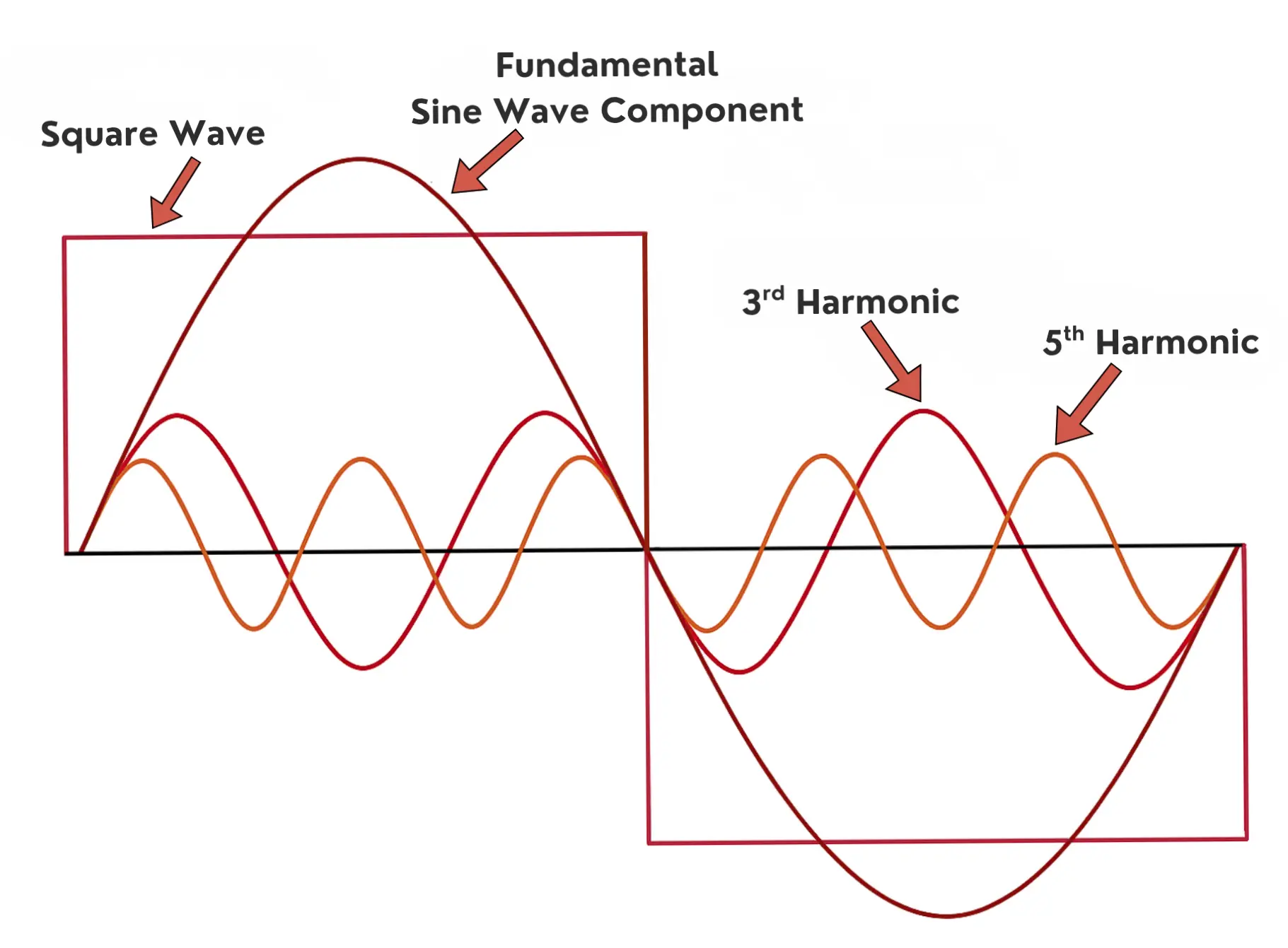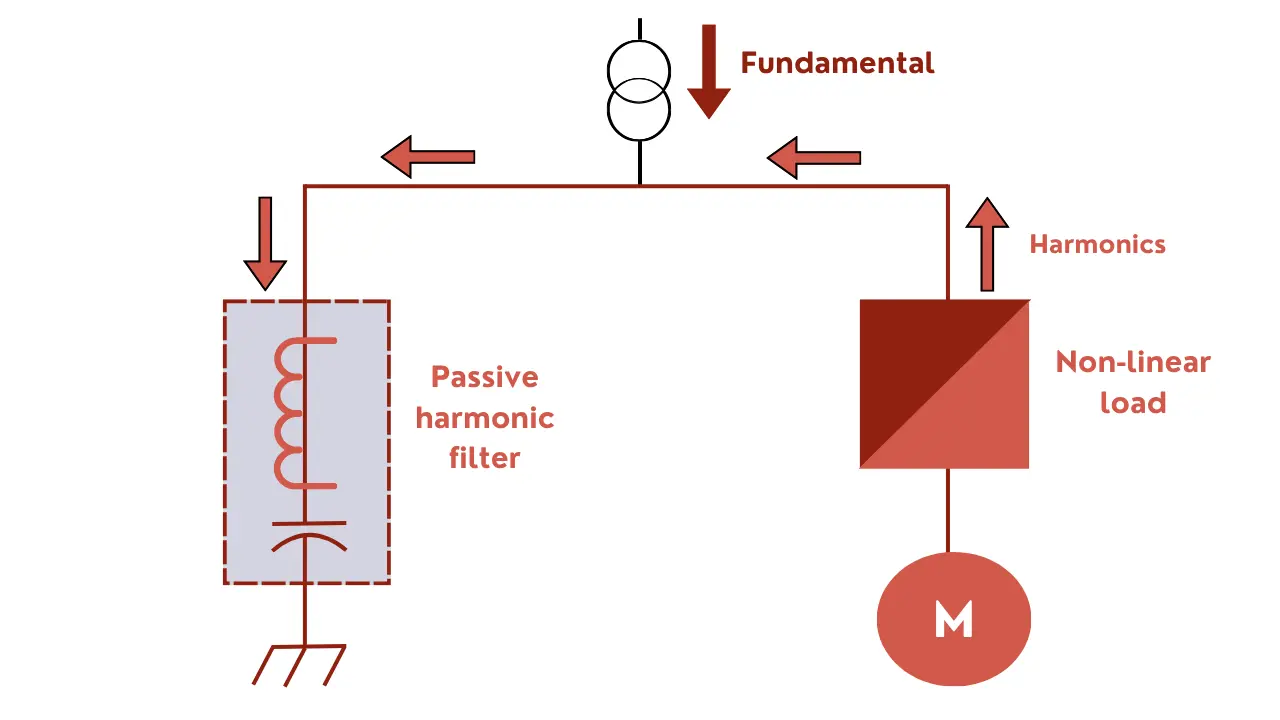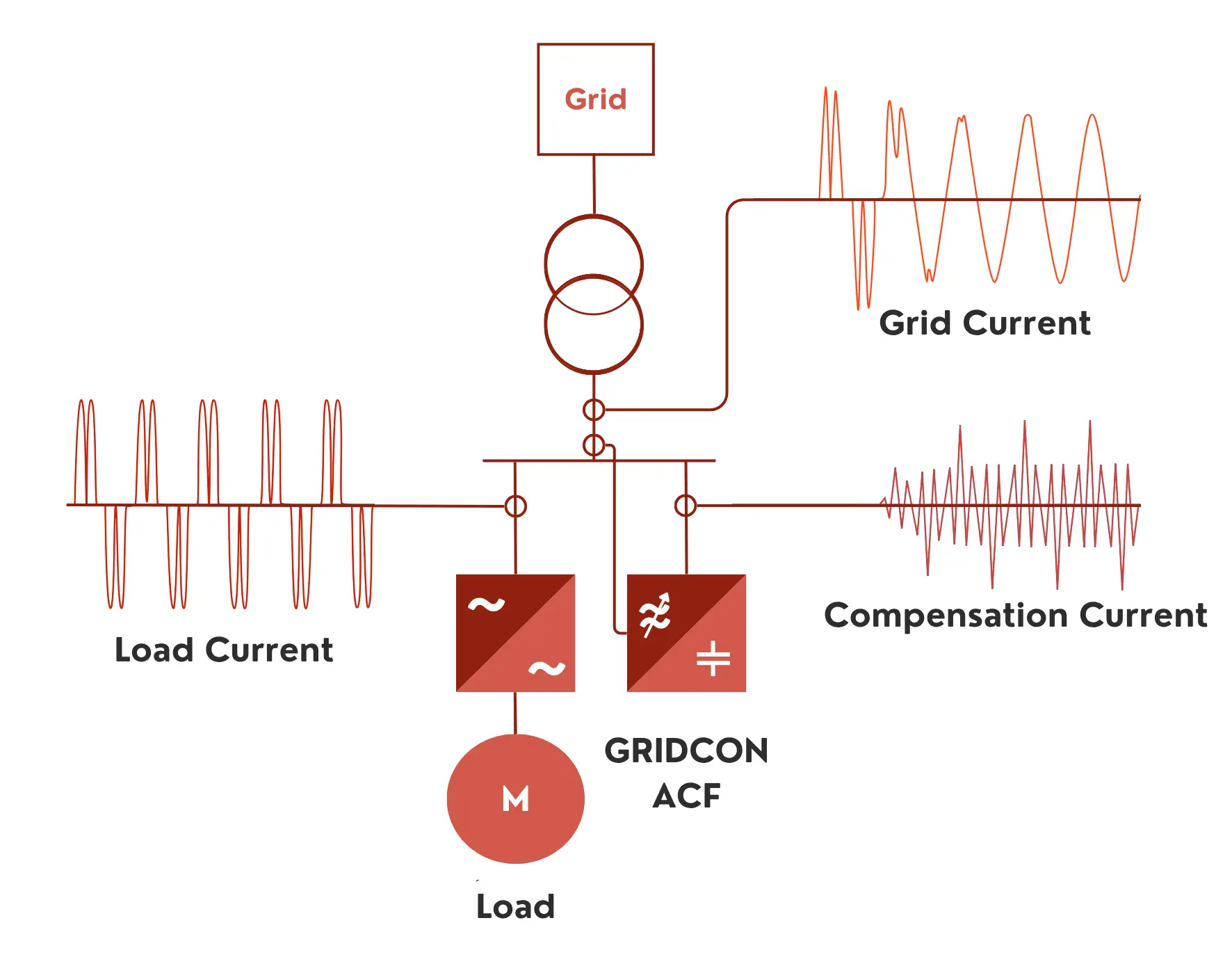Causes, Impact and Mitigation of Harmonics in Power System

In a power system, harmonics are like undesired "extra waves" that surround the main electrical current. In an ideal system, electricity flows in a smooth, steady wave. However, this wave can be distorted in real life by devices like computers, LED lights, and industrial equipment, causing smaller, faster waves known as harmonics. These harmonics may result in complications like overheating equipment, waste of energy, or even damage to sensitive devices.
Understanding Harmonics: The Basics
What Are Harmonics?
The waveforms of voltage and current in an ideal electrical system are smooth and sinusoidal. When waveforms diverge from this sinusoidal form, distortions at integer multiples of the fundamental frequency (e.g., 50 Hz or 60 Hz) are introduced, resulting in harmonics. For example:
- 3×Fundamental Frequency is the third harmonic.
- 5 × Fundamental Frequency for the 5th Harmonic.

Usually, the interaction of non-linear loads with the electrical supply results in these distortions. Unwanted energy produced by harmonics can harm the system if it is not controlled, but it does not contribute to any beneficial work.
Fourier Analysis and Integer Multiples of Fundamental Frequency:
Since Fourier analysis shows how a distorted waveform is made up of the fundamental frequency and its integer multiples, it is crucial for analyzing harmonics. Engineers can find and fix harmonic issues to ensure dependable and effective power system performance by examining these components. A complicated, distorted waveform can be broken down into a sequence of sine and cosine waves at various frequencies using Fourier analysis.
Types of Harmonics
There are 2 types of harmonics in power system.
- Even harmonics
- Odd harmonics
Odd vs. Even Harmonics
| Aspect | Odd Harmonics | Even Harmonics |
|---|---|---|
| Frequency | odd multiples of the fundamental frequency | even multiples of the fundamental frequency |
| Common source | Non-linear loads (e.g., computers , VFDs) | Asymmetrical loads or faulty equipment |
| Prevalence | Very common | Rare |
| Neutral Current | Significant in 3rd, 9th, 15th harmonics | Minimal effect |
| Waveform Distortion | Symmetrical distortion | Asymmetrical distortion |
| Impact | Major concern in power systems | Less severe but still problematic |
Triplen Harmonics (3rd, 9th, 15th) and Neutral Overloading
In the world of harmonics, Triplen harmonics hold a special place—they are the harmonics that are odd multiples of the third harmonic (3rd, 9th, 15th, etc.). These harmonics are particularly problematic in power systems, especially in three-phase systems, because of their unique behavior and the stress they place on the neutral wire. Let’s break down what Triplen harmonics are, why they occur, and how they lead to neutral overloading.
- 3rd harmonic: 150 Hz (in a 50 Hz system) or 180 Hz (in a 60 Hz system)
- 9th harmonic: 450 Hz or 540 Hz
- 15th harmonic: 750 Hz or 900 Hz
Imagine a commercial building with hundreds of computers and LED lights connected to a three-phase power system. These devices generate significant 3rd harmonic currents. In the neutral wire, the 3rd harmonic currents from all three phases add up, causing the neutral wire to carry much more current than it was designed for. Over time, this can lead to overheating and potential failure of the neutral wire.
Key Metrics
Total Harmonic Distortion (THD)
Total Harmonic Distortion (THD) measures the distortion in a waveform caused by harmonics. It compares the sum of all harmonic components to the fundamental frequency. For voltage (THD-V) or current (THD-I), THD is calculated as:
High THD indicates poor power quality, leading to overheating, equipment damage, and inefficiency. Common sources include non-linear loads like computers and LED lights. To maintain system reliability, THD should be kept within limits (IEEE 519 recommends <5% for voltage and <20% for current). Proper mitigation, like filters and balanced loads, ensures efficient operation.
Individual Harmonic Distortion (IHD)
Individual Harmonic Distortion (IHD) measures the contribution of each harmonic to total distortion, expressed as a percentage of the fundamental frequency. Calculated as:
where Vn is the harmonic voltage and V1 is the fundamental voltage. IHD helps identify problematic harmonics (e.g., 3rd, 5th) caused by non-linear loads like computers or LED lights. Standards like IEEE 519 set IHD limits (e.g., <3% for voltage) to ensure power quality. By analyzing IHD, engineers can target specific harmonics with filters or equipment upgrades, reducing distortion, improving efficiency, and preventing equipment damage. IHD is essential for maintaining reliable power systems.
We recently published a blog on the Importance of Power Quality in Power Systems. Checked it out to grasp the information available in this blog.
Causes of Harmonics in Power Systems
Harmonics in power systems are primarily caused by non-linear loads that distort the sinusoidal waveform of the voltage or current. Here are the main causes:
- Variable Frequency Drives (VFDs):Used in motors, they generate harmonics due to high-frequency switching.
- Unbalanced Loads:Uneven distribution of single-phase loads in a three-phase system.
- Magnetic Saturation:Transformers and motors operating near or beyond their magnetic limits.
- Arc Furnaces and Welders:Industrial equipment that causes abrupt current changes.
- Switching Power Supplies:Found in electronic devices, they produce high-frequency harmonics.
- Renewable Energy Systems:Solar inverters and wind turbine converters inject harmonics into the grid.
- Resonance:Interaction between system capacitance and inductance amplifies specific harmonics.
- Faulty Equipment:Malfunctioning devices that introduce distortion into the system.
- Half-Wave Rectifiers:Asymmetrical operation generates even harmonics.
- Fluorescent Lighting:Electronic ballasts in lighting systems produce harmonics.
- Unfiltered Devices:Equipment without proper harmonic filtering mechanisms.
- High-Power Industrial Processes:Large motors, induction heaters, and welding machines.
Impact of Harmonics on Power Systems
Harmonics pose significant challenges to power systems, primarily by causing overheating and stress on equipment, which can lead to premature failure and reduced operational lifespan. In transformers and motors, harmonic frequencies increase eddy currents and hysteresis losses, generating excessive heat and further straining these components. Additionally, harmonics can trigger resonance conditions, overvoltage, and excessive currents in capacitor banks, often resulting in failures and disruptions.
Another critical issue is the impact of harmonics on system protection and power quality. Harmonic distortion can interfere with relay operation, causing false tripping or failure to activate, which compromises the reliability of protective systems. The distortion of voltage and current waveforms also degrades power quality, leading to unstable performance in sensitive equipment. Furthermore, voltage fluctuations caused by harmonics may result in flickering lights and erratic device behavior, while triplen harmonics (3rd, 9th, 15th) accumulate in neutral conductors, creating overheating risks and potential fire hazards.
Beyond operational inefficiencies, harmonics contribute to increased energy losses across the system. Higher RMS currents due to harmonics elevate resistive losses (I²R) in cables, causing overheating and reducing overall efficiency. The presence of harmonics also lowers the power factor, potentially incurring penalties from utility providers. Moreover, excessive harmonics increase the risk of arc flash incidents and equipment failures, posing serious safety concerns. Failure to mitigate harmonics can lead to non-compliance with power quality standards, resulting in fines or operational restrictions, underscoring the need for effective harmonic management.
How Harmonics affect Renewable Energy Integration
Harmonics significantly impact renewable energy integration by distorting voltage and current waveforms, leading to power quality issues. Inverters used in solar and wind systems generate harmonics due to their switching operations, which can cause resonance and overloading in the grid. This affects the stability and efficiency of renewable energy systems, leading to malfunctioning of protective relays and equipment damage. Harmonics also increase energy losses and reduce the power factor, impacting overall system performance. Compliance with standards like IEEE 519 becomes challenging. Proper filtering, harmonic mitigation, and grid design are essential to ensure seamless integration of renewables while maintaining power quality and reliability.
We recently published a blog on Renewable Energy Integration Challenges and Solutions in Power Systems. Checked it out to grasp the information available in this blog.
Mitigation Strategies for Harmonics
-
Passive Harmonic Filters
Passive filters are designed as LC or LCR circuits tuned to the harmonic frequencies they aim to eliminate (e.g., 5th, 7th, 11th harmonics). They provide a low-impedance path for harmonic currents to flow, diverting them away from the power system. There are 2 types of passive harmonic filters.

I. Tuned Filters:
- Designed to target specific harmonic frequencies(e.g., 5th, 7th, 11th).
- Use inductors (L)and capacitors (C) to create a low-impedance path for selected harmonics, diverting them from the system.
- Applications:Industrial plants with dominant harmonics (e.g., steel mills, data centers).
II. Broadband Filters:
- Mitigate a wide range of harmonics (e.g., 2nd to 25th).
- Effective for systems with multiple harmonic sources.
-
Capacitor Banks with Reactors
- Use power electronics (IGBTs) to inject equal-but-opposite harmonic currents, canceling distortions in real time.
- Continuously monitor the load and adapt to changing harmonic conditions.

-
Active Harmonic Filters (AHFs)
- Use power electronics (IGBTs)to inject equal-but-opposite harmonic currents, canceling distortions in real time.
- Continuously monitor the load and adapt to changing harmonic conditions.

Key Considerations for Choosing Harmonic Mitigation Strategy
| Strategy | Best For | Pros | Cons |
|---|---|---|---|
| Passive filters | Fixed, predictable harmonics | Low cost, simple design | Fixed, tuning resonance risks |
| Active filters (AHFs) | Dynamic, variable harmonics | Adaptable, wide frequency range | Higher cost, complexity |
| Capacitor Banks + reactors | Power factor correction + basic mitigation | Cost-effective for dual purposes | Limited harmonic mitigation scope |
Harmonic-Resistant Equipment
K-Rated Transformers
In power systems plagued by harmonics, K-Rated Transformers are a specialized solution designed to handle the additional stresses caused by harmonic distortion. Unlike standard transformers, K-rated transformers are built to withstand the overheating and efficiency losses associated with non-linear loads, making them essential in environments with high harmonic content.

IEEE 519-Compliant Inverters
As the integration of renewable energy and power electronics grows, maintaining power quality and compliance with standards like IEEE 519 becomes critical. IEEE 519-compliant inverters are designed to limit harmonic distortion, ensuring reliable and efficient operation of power systems. These inverters play a key role in meeting regulatory requirements and protecting equipment from harmonic-related damage.
We recently published a blog on The Importance of Equipment Maintenance Plan for Electrical Power Systems. Checked it out to grasp the information available in this blog.
Future Trends in Harmonic Mitigation
Solid-State Circuit Breakers
The power industry is evolving rapidly, driven by renewable energy integration, smart grids, and the proliferation of power electronics. Harmonic mitigation is no exception—here’s a glimpse into cutting-edge trends, with a focus on solid-state circuit breakers (SSCBs) and their revolutionary role.
AI-Driven Harmonic Analysis
Machine learning models predict harmonic patterns and optimize filter performance in real time. Example: AI-powered inverters in solar farms self-adjust to mitigate harmonics based on grid conditions.

Advanced Inverter Technologies
Semiconductors significantly enhance harmonic mitigation. Their ultra-fast switching speeds reduce switching losses and enable precise control of voltage/current waveforms, minimizing harmonic generation. SiC/GaN inverters operate at higher frequencies, allowing smaller, more efficient filters to suppress residual harmonics. Additionally, their superior thermal performance ensures stable operation under heavy loads, reducing harmonic distortion risks.
Summarizing, Harmonics pose significant challenges to power systems, causing equipment damage, energy losses, and power quality degradation. However, with the advent of advanced inverter technologies leveraging SiC (Silicon Carbide) and GaN (Gallium Nitride) semiconductors, the landscape of harmonic mitigation is transforming. These cutting-edge materials enable faster switching speeds, higher efficiency, and precise control, reducing harmonic generation and improving system performance.
At AllumiaX Engineering, we are committed to providing high quality harmonic analysis for industrial and commercial power systems. We pioneer these innovations, providing tailored solutions that ensure compliance with standards like IEEE 519, enhance power quality, and future-proof your systems. By embracing these technologies, industries can achieve cleaner, more reliable power systems, paving the way for a sustainable energy future.
Partner with AllumiaX Engineering to harness the power of advanced technologies and lead the charge in harmonic mitigation and energy efficiency. Contact us today to get started on optimizing your power system.

Stay Sharp & Join our Mailing List!
Subscribe to Allumiax Blog for updates on power system studies, tips, guides and insights on electrical engineering from industry leaders.




